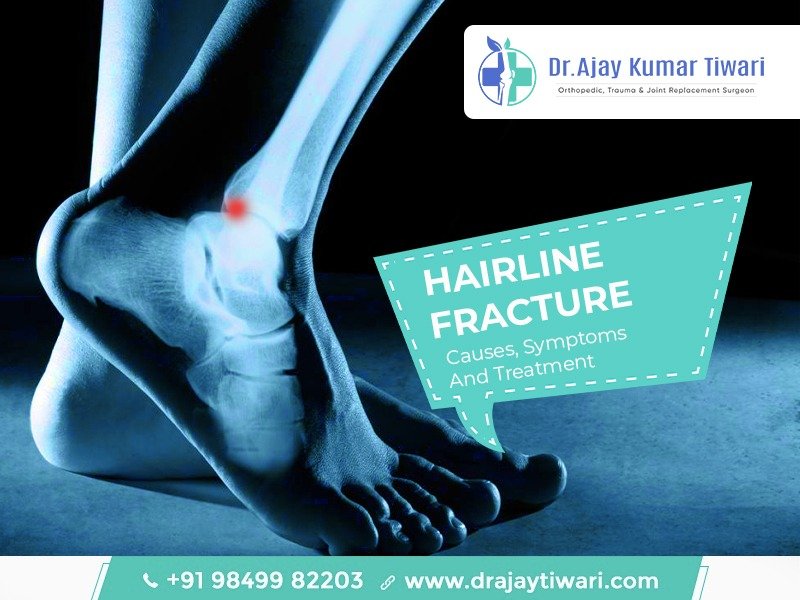
Hairline Fractures causes, symptoms and treatment
Hairline fractures, often called stress fractures, are small cracks or bruises that develop within a bone. They are more commonly seen in athletes, especially those involved in running and jumping. People who are suffering from osteoporosis are at a higher risk of developing hairline fractures.
In many cases, hairline fractures occur from overuse or repetitive movements that cause microscopic damage to bones over the long term. The likelihood of getting this injury increases when you don’t give yourself sufficient time to heal between activities.
In particular, hairline fractures occur in the femur and tibia of the leg and foot. While you run and jump, these bones take on heavy stress. A majority of problems arise in the second and third metatarsal areas of the foot. The reason for this is that these bones are thin, and when you push off to run or jump with your foot, they are the point of impact.
Hairline fractures are more commonly seen in your heels, ankle bones, and navicular (upper midfoot bone).
Symptoms of having a hairline fracture
Symptoms might differ from one person to the other based on the severity of the fracture. However, a sharp pain is the most common symptom of a hairline fracture. Performing activities that strain the fractured bone will aggravate the pain. This can restrict the mobility of a person.
Some other signs and symptoms may include swelling, bruising, and tenderness.
Causes & risk factors of hairline fractures
Repetitive or overuse activities are the most common causes of hairline fractures. They can occur as a result of changes in activity duration or frequency. This means that though you may run daily, sudden changes in your distance or the number of times you run every day or week can lead to this injury.
As a result of various activities, bones adapt to increased forces, forming new bones in place of old ones, a process known as remodelling. Resorption and reconstruction of bone tissue happen during remodelling.
If bones are subjected to unusual forces without giving proper time for recovery and reconstruction of new bones, this puts you at risk of stress fractures.
Risk factors
A number of factors can contribute to stress fractures, which include:
- Playing certain high-impact sports like basketball, football, tennis, dance, or gymnastics.
- Increased activity – such as increasing the intensity and duration of exercising, shifting lifestyle suddenly to an active training regimen, etc.
- Stress fractures are more likely to occur in women with abnormal or absent menstrual periods.
- People with foot problems like flat feet or high, rigid arches are also at risk of developing stress fractures. Even wearing worn footwear can also lead to hairline fractures.
- Bone conditions like osteoporosis make your bones weak, which puts you at risk of stress fractures.
- Previous stress fractures
- Lack of nutrients like vitamin D and calcium in your diet.
- Improper technique and equipment while playing sports
Treatment for hairline fractures
It is most likely that hairline fractures can heal on their own if the affected area is not subjected to weight-bearing activities that put stress on them.
Bone healing takes time, so giving the bone time to heal is essential. This may take a few weeks to several months. In the meantime, you can try some home remedies to manage pain and swelling.
Follow the RICE method:
- rest
- ice
- compression
- elevation
NSAIDs like ibuprofen and aspirin can help to manage pain and swelling.
It is expected that full mobility will be regained after 6 to 8 weeks of full recovery.
Sometimes, doctors may recommend wearing protective equipment, crutches, and a splint to minimise the stress placed on the fractured bones. If the hairline fracture does not heal on its own, it may need to be fixed surgically. However, it is rare.
Prevention
Follow the simple steps mentioned below to prevent stress fractures.
- Make the changes in your new exercise programme gradually.
- Use proper footwear and other protective equipment.
- Avoid overstressing one part of your body by adding low-impact exercises to your exercise routine.
- Get proper nutrition
Stress fractures can cause chronic problems as they do not heal properly. Additional stress fractures may occur if underlying causes are not addressed. So consult an experienced orthopaedic doctor to get quality treatment. Dr. Ajay Tiwari, one of the best doctors for hairline fractures in Hyderabad, can help you with any kind of bone problem. To book an appointment with the doctor, you can call +91 98499 82203.





